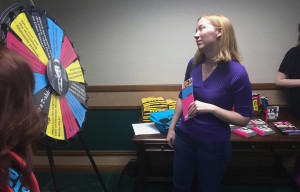
About 50 students, faculty and community members, including University President Jesse Rogers, gathered at the Moffett Library Rare Books Room on March 28, for the release of Print: Nolan A. Moore III Collection — the Heritage of Print.
In a speech given to attendees, Rogers’ excitement about the collection was evident.
“It is ours,” he said. “When we took the collection we had little knowledge of its value. There are universities all over this nation that have nothing close to this print collection.”
Attendees toured the collection, enjoyed free refreshments including wine, and participated in a scavenger hunt, hoping to win free T-shirts.
Associate University Librarian of Technical Services Cortny Bates said, “I show people the collection and 99 percent of the people say, ‘I didn’t know you guys had this.’ So this is a way to get the word out. I know Nolan Moore’s intention. When he died he wanted it to go to a university as a research tool, and it was between us an UT-Austin. He didn’t want it stacked up in a room. He wanted people to see it and use it and to learn from it.”
Courtney Gil, fine arts junior, said, “I definitely loved looking at the articles of the slavery and how everything was in their own point of view. Everybody experiences things differently than we would.”
Bates said she reached out to other faculty members to collaborate on the book meant to promote the rare book collection.
She said, “Well I didn’t want to do it all myself, and I also thought if I had some names attached to it that it would get a little bit more publicity. The whole point of the book was to get more publicity for the collection.”
Bates gave more information on the thought process behind the book’s creation, which includes information on newspaper articles, comic books, and a Tibetan Scroll from 700 AD, as well as narratives written by Nolan Moore as he assembled the collection.
“The idea was to feature 25 pieces from the collection to give people a small glimpse of what we had,” Bates told the crowd. “I asked several people to pick a piece or pieces they liked most from the collection and to write a personalized narrative or description about those pieces.”
Peter Fields, associate professor of English, wrote a description of Shakespeare’s second folios and edited the entire book. He said he did not know that the collection included a 1688 edition of Paradise Lost, a poem he uses in the curriculum in one of his literature classes.
“As I look at it now, as I stand and look at this printed ediiton of the manuscript from 1688, what I’m struck by as I look at The Argument, which is a summary, is how readable it is,” Fields said. “It just lends itself right away to comprehension. Milton would be surprised today that people considered his syntax and some of his word choices difficult. He struggled to be as accessible as possible.”












